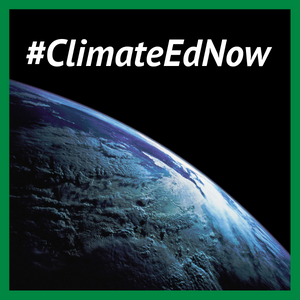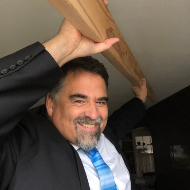Scientific study of the size and age of the universe, and of the geological and fossil record on Earth, have helped us to understand that humanity is a blip in time on a speck in space. Because everyone we know and love is encapsulated in this blip and speck, we treasure it deeply and want to preserve its richness, its diversity, and its life-supporting aspects. We are profoundly lucky to live right here and right now. We have a duty to preserve our luck for future generations. This does not speak to the absence or presence of forces beyond nature, but it does speak to the awesomeness and wonder of nature. Understanding the science of Earth systems may deepen our sense of wonder and of our responsibility for sharing it forward.
We educators are lucky to do what we do.
Love and beauty will persist
Engaging in the important work of climate and energy education can be profoundly depressing. Understanding the environmental challenges we face means confronting challenges that are on a scale perhaps never faced by humanity. Civilization and agriculture arose and came to thrive in a relatively stable climate, and it was the general stability of the climate that allowed the rise of civilizations. The climate is no longer as stable as it was, and is changing in some ways that will be difficult to adapt to and some that are difficult to predict. Teaching about it is also, however, an opportunity for full engagement in a purposeful life.
And though the climate is changing, and we will almost certainly lose some wonderful environments, species, and human settlements, we won’t lose it all, and to at least some degree new ones will also emerge. If the work gets you down, consider, for example, spending time in a natural environment. Many places that we consider of great beauty and value have been impacted by humans, such as in the widespread forests of the Northeastern US. Regrettably, almost none of this forest is original “old growth”—that was lost a few generations ago to humanity’s hunger for fuel, building materials, and other land use. But in certain respects there is more nature in these areas than there was a century ago. And many of the lakes and rivers in North America are much cleaner than they were fifty years ago, as is the air of many cities. These are just a few examples of many stories in which increased scientific awareness, understanding, and change that people worked together to make have made a positive difference.
Our work as educators is central to the protection and expansion life sustaining ecosystems - and engaging in that work is perhaps the single most effective way to ward off climate anxiety and depression. Engage with nature, and engage with the work. It’s the best chance we’ve got.
This article is adapted from Chapter 1 of The Teacher-Friendly Guide to Climate Change, “Why Teach About Climate Change.” The full text of the book is freely available. Print copies may be purchased online. The book is one part of the suite of Paleontological Research Institution resources to support teaching and learning about climate and energy. Those resources include the climate pages of Earth@Home where you’ll find Why Talk About Climate Change, which translates the content of the chapter excerpted here into a format for a more general audience than just educators. The Teacher-Friendly Guide to Climate Change is friendly to more than just teachers already, and we’re making it friendlier. Four of the book’s 12 chapters have already been adapted for Earth@Home’s climate pages and the rest will be added in the coming months. This is intended to serve as a text for high school and college students as well as a resource for anyone who wants to deepen their understanding of climate change.
Read other essays from our #ClimateEdNow series.

 John Holdren was president of the American Association for the Advancement of Science when he made these remarks. His summation of the problem of climate change concisely describes the choices we face and does so without the level of pessimism sometimes included in such pronouncements. When it comes to climate change there is reason for pessimism, but there is also reason for hope. We have the capacity to act, and many of the actions we might take have benefits beyond climate. They also have the potential to save money in both the short and long term and to improve health and other measures of quality of life.
John Holdren was president of the American Association for the Advancement of Science when he made these remarks. His summation of the problem of climate change concisely describes the choices we face and does so without the level of pessimism sometimes included in such pronouncements. When it comes to climate change there is reason for pessimism, but there is also reason for hope. We have the capacity to act, and many of the actions we might take have benefits beyond climate. They also have the potential to save money in both the short and long term and to improve health and other measures of quality of life.